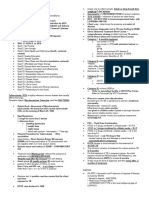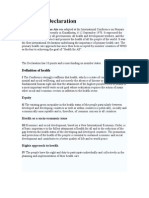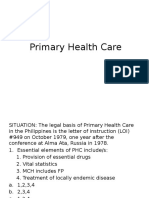0 ratings0% found this document useful (0 votes)
112 viewsPrimary Health Care
Primary Health Care
Uploaded by
Julienne Sanchez-SalazarThis document discusses primary health care (PHC). It describes PHC as a practical approach to providing essential health services that are community-based, accessible, acceptable, and sustainable at a cost communities and governments can afford. The key elements of PHC include education on health problems, promotion of nutrition and food supply, basic health services and sanitation, maternal and child health care, immunization, disease prevention and control, treatment of common injuries and illnesses, and provision of essential drugs. PHC aims to achieve health for all through community participation, inter-sectoral cooperation, and ensuring access to essential and affordable health technologies.
Copyright:
© All Rights Reserved
Available Formats
Download as DOCX, PDF, TXT or read online from Scribd
Primary Health Care
Primary Health Care
Uploaded by
Julienne Sanchez-Salazar0 ratings0% found this document useful (0 votes)
112 views3 pagesThis document discusses primary health care (PHC). It describes PHC as a practical approach to providing essential health services that are community-based, accessible, acceptable, and sustainable at a cost communities and governments can afford. The key elements of PHC include education on health problems, promotion of nutrition and food supply, basic health services and sanitation, maternal and child health care, immunization, disease prevention and control, treatment of common injuries and illnesses, and provision of essential drugs. PHC aims to achieve health for all through community participation, inter-sectoral cooperation, and ensuring access to essential and affordable health technologies.
Original Description:
PHC
Copyright
© © All Rights Reserved
Available Formats
DOCX, PDF, TXT or read online from Scribd
Share this document
Did you find this document useful?
Is this content inappropriate?
This document discusses primary health care (PHC). It describes PHC as a practical approach to providing essential health services that are community-based, accessible, acceptable, and sustainable at a cost communities and governments can afford. The key elements of PHC include education on health problems, promotion of nutrition and food supply, basic health services and sanitation, maternal and child health care, immunization, disease prevention and control, treatment of common injuries and illnesses, and provision of essential drugs. PHC aims to achieve health for all through community participation, inter-sectoral cooperation, and ensuring access to essential and affordable health technologies.
Copyright:
© All Rights Reserved
Available Formats
Download as DOCX, PDF, TXT or read online from Scribd
Download as docx, pdf, or txt
0 ratings0% found this document useful (0 votes)
112 views3 pagesPrimary Health Care
Primary Health Care
Uploaded by
Julienne Sanchez-SalazarThis document discusses primary health care (PHC). It describes PHC as a practical approach to providing essential health services that are community-based, accessible, acceptable, and sustainable at a cost communities and governments can afford. The key elements of PHC include education on health problems, promotion of nutrition and food supply, basic health services and sanitation, maternal and child health care, immunization, disease prevention and control, treatment of common injuries and illnesses, and provision of essential drugs. PHC aims to achieve health for all through community participation, inter-sectoral cooperation, and ensuring access to essential and affordable health technologies.
Copyright:
© All Rights Reserved
Available Formats
Download as DOCX, PDF, TXT or read online from Scribd
Download as docx, pdf, or txt
You are on page 1of 3
August 17, 2015
Dr. Camacho 4-6 pm
Primary Health Care
The situation before PHC
Widening gap between haves and the have-nots in a community and
between communities.
Health resources are limited; more on the urban than on the rural areas
Disadvantaged groups have limited access to health care services.
Primary Health Care
A practical approach to the effective provision of essential health services
that are community-based, accessible, acceptable & sustainable at a
cost which the community & the government can afford.
Cooperation between government, community and private sector.
Full participation and active involvement of the community-> self-reliance to
achieve acceptable level of health and well-being.
Recognizes the inter-relationship between health and overall socioeconomic
development.
7 key points to the development of PHC
1. Inter-sectoral cooperation
2. Community participation
3. Relations inside health and medical practices
4. Appropriate technology
5. Manpower development
6. Financial support
7. Management
PHC became the thrust of all stakeholders in the improvement of health of all
people throughout the world
Can be viewed in 3 different dimensions:
1. As a structure of health system
2. As a service or health activities
3. As an approach
Key elements of PHC (WHO 1978)
1. Education concerning prevailing health problems and the methods
of preventing and controlling them.
2. Promotion of food supply and proper nutrition
3. An adequate supply of water and basic health sanitation
4. Maternal and child health care including Family planning and
reproductive health.
5. Immunization against the major infective diseases.
6. Prevention and control of locally endemic diseases
7. Treatment of common injuries and illnesses.
8. Provision of essential drugs.
4 Pillars on which health for all must be based on (WHO)
1. Political and societal commitment and determination to move
towards health for all as the main social target for the coming
decades.
2. Community participation, the active involvement of the people
and the mobilization of societal forces for health development.
3. Inter-sectoral cooperation between the health sectors such as
agriculture, education, communication, industry, energy,
transportation, public works and housing.
4. System support to ensure the essential health care and
scientifically sound and affordable health technology are
available to all people.
PHC Fourfold objectives for both developing and industrialized countries.
To enable people:
1. To seek better health at home, in schools, in fields and in factories.
2. To prevent diseases and injuries, instead of relying on doctors to cure
illnesses that could have been avoided
3. To exercise their right and responsibility in sharing their environment,
bringing about conditions that make it possible and easier to live a healthy
life.
4. To participate and exercise control in managing health and related systems,
and to ensure that
the basic prerequisites for health and access to health care are available.
Strategies of PHC
1. Increasing opportunity for community participation in local level
2. Interdisciplinary, intra-sectoral and inter-sectoral linkages with other
government and private agencies will be developed.
3. Emphasis on partnership so that those in health system and the community
view each other as partners rather than merely providers and receivers of
health care respectively
PHC Models for level of people participation (Galvez-Tan , 1998)
1. Hospital or clinic-based PHC model
Characteristically authoritarian in nature
Health is sole responsibility of doctors
Example: Medical mission
Hence, no significant change in the community is expected
2. Community-oriented PHC model
Health for the people typically paternalistic in nature
Health is the responsibility of doctors and other health professionals;
community members are regarded as mere beneficiaries of health care
Peoples opinions are taken into consideration but their participation
ends with the initial interaction with the health care worker.
3. Community-based PHC model
Described to be democratic, signifying health WITH the people
Community members are not only consulted but have active
participation in the identification and prioritization of their health
problems
They join in looking for possible solutions of theis communitys problem
4. Community-managesd PHC model
The highest and most liberating model with the greatest level of
people participation
It denotes health BY the people
People are regarded as managers of their own health programs and
activities
Hence they tend to become self-reliant- structural change in the
community
Health is in the hands of the people.
GOAL: to attain health for all the fiipinos by year 2000
This plan commits the DOH to:
1. Provide quality health care which communities and government can afford
2. Support communities in planning, organizing, implementing, monitoring, and
evaluating community-based health programs
3. Reallocate its resources to meet the priority health needs as expressed by the
community
4. Strengthen the managerial and technical capacities of health workers
5. Coordinate and encourage the development of appropriate health
technologies.
6. Coordinates planning and implementation of inter-sectoral and intra-sectoral
health and related activities
7. Monitor the changes of health status of the population.
PHC principles and strategies
1. accessibility, availability, acceptability, and sustainability/affordability
2. provision of high quality, basic, and essential health services
3. community participation
4. self-reliance
5. recognition of interrelationship between health and development
6. Social mobilization
7. decentralization
You might also like
- DOH RHU Field ManualDocument45 pagesDOH RHU Field ManualSha Estrella88% (8)
- Biochemistry National Board Exam ReviewDocument42 pagesBiochemistry National Board Exam ReviewJulienne Sanchez-Salazar75% (4)
- National Tuberculosis Prevalence Survey (NTPS) 2016 Philippines PDFDocument146 pagesNational Tuberculosis Prevalence Survey (NTPS) 2016 Philippines PDFLinius Cruz100% (1)
- School of Health and Allied Health Sciences Nursing DepartmentDocument2 pagesSchool of Health and Allied Health Sciences Nursing DepartmentJuviely PremacioNo ratings yet
- CHAPTER 24 Williams OBDocument3 pagesCHAPTER 24 Williams OBJulienne Sanchez-Salazar100% (2)
- Pathophysiology of Ectopic PregnancyDocument3 pagesPathophysiology of Ectopic PregnancyJulienne Sanchez-Salazar100% (2)
- CHN Lecture SY2015-2016 1 SemesterDocument141 pagesCHN Lecture SY2015-2016 1 SemesterhahahahaaaaaaaNo ratings yet
- Unit 7 Preventive PediatricsDocument16 pagesUnit 7 Preventive PediatricsSanthosh.S.U58% (12)
- Ward Minimum Health Care Package.Document64 pagesWard Minimum Health Care Package.rainmaker1978100% (9)
- CPHM TransesDocument5 pagesCPHM TransesElizer Robles Jr.No ratings yet
- ExamDocument4 pagesExamMARC JOSHUA SARANILLONo ratings yet
- Cough Up 3-5ml SputumDocument28 pagesCough Up 3-5ml Sputumnipajohnpaul7No ratings yet
- Module 1 Overview of Public Health Nursing in The PhilippinesDocument4 pagesModule 1 Overview of Public Health Nursing in The PhilippinesJJ VeranoNo ratings yet
- Doh Updated Prog M-RDocument49 pagesDoh Updated Prog M-Rdeeday echavezNo ratings yet
- Review University For Midwives, Inc.: Successfully Training Filipino Nurses and Midwives For Global SettingDocument8 pagesReview University For Midwives, Inc.: Successfully Training Filipino Nurses and Midwives For Global SettingKelly Posadas-MesinaNo ratings yet
- Community Health NursingDocument5 pagesCommunity Health NursingAmy Canonizado ViniegasNo ratings yet
- Public Health: - Dr. C.E. WinslowDocument13 pagesPublic Health: - Dr. C.E. WinslowMeia JaycelNo ratings yet
- 100 Item ObstetricsDocument49 pages100 Item ObstetricsAlex Olivar, Jr.No ratings yet
- Ecology: of The Disease or Dynamic of Disease Transmission Chapter TwoDocument42 pagesEcology: of The Disease or Dynamic of Disease Transmission Chapter TwoCabdi WaliNo ratings yet
- Phpe 210Document2 pagesPhpe 210Reg LagartejaNo ratings yet
- Nursing Pharmacology (Lecture) - REVIEWER #1Document4 pagesNursing Pharmacology (Lecture) - REVIEWER #1rocket12shipsNo ratings yet
- Which Is The Primary Goal of Community Health NursingDocument20 pagesWhich Is The Primary Goal of Community Health NursingKeepItSecretNo ratings yet
- EINC ReviewerDocument4 pagesEINC ReviewerLloyd BaylonNo ratings yet
- Nursingresearch Unlocking The Secrets 111012003304 Phpapp01Document227 pagesNursingresearch Unlocking The Secrets 111012003304 Phpapp01jcruzada100% (1)
- CHN Test 1 With AnswerDocument12 pagesCHN Test 1 With AnswerKia Garcia100% (1)
- 3 - Primary Health CareDocument5 pages3 - Primary Health CareLynnelljhyen MALUBAYNo ratings yet
- Funda LecDocument8 pagesFunda LecKimberly Anne Capiral NunogNo ratings yet
- Healthcare Delivery System in The PhilippinesDocument13 pagesHealthcare Delivery System in The PhilippinesRon Ar IcaNo ratings yet
- Doh MCNDocument14 pagesDoh MCNCbrc CebuNo ratings yet
- Health Education Prelim)Document3 pagesHealth Education Prelim)Joselyn Cabiles-GanhinhinNo ratings yet
- CHN TopicsDocument19 pagesCHN TopicsKristine AnaenNo ratings yet
- Family Nursing AssessmentDocument9 pagesFamily Nursing AssessmentrodcyruskentNo ratings yet
- CHN SyllabusDocument6 pagesCHN SyllabusEdwin Delos Reyes AbuNo ratings yet
- CHN Lecture WCCDocument75 pagesCHN Lecture WCCMeeKo VideñaNo ratings yet
- Manuscript CoparDocument70 pagesManuscript CoparShamelle Tobias100% (1)
- NCM104Document81 pagesNCM104Sarah Shane Cortes CortesNo ratings yet
- Chapter 01 - Introduction To DrugsDocument3 pagesChapter 01 - Introduction To DrugsDaniel BenitezNo ratings yet
- The Continuous Process Improvement ModelDocument2 pagesThe Continuous Process Improvement ModelJonas Marvin AnaqueNo ratings yet
- Laws Affecting The Practice of NursingDocument3 pagesLaws Affecting The Practice of NursingAce EsperanzateNo ratings yet
- Expanded Program On ImmunizationDocument15 pagesExpanded Program On ImmunizationReygie MarsadaNo ratings yet
- اسئلة تنافسي تمريض صحة مجتمع ٢٠١٩ PDFDocument10 pagesاسئلة تنافسي تمريض صحة مجتمع ٢٠١٩ PDFbilal hadiNo ratings yet
- Epikus Study GuideDocument4 pagesEpikus Study GuidePatricia EspirituNo ratings yet
- Professional Adjustment and ResearchDocument26 pagesProfessional Adjustment and ResearchjeshemaNo ratings yet
- Seminar On Primary Health Care AND Primary Health Centre: Presented By: Ms. Neeta JimmichenDocument99 pagesSeminar On Primary Health Care AND Primary Health Centre: Presented By: Ms. Neeta JimmichenneetsjimmichenNo ratings yet
- Midwifery Obstetrics and Fundamentals of Health Care Part 1Document13 pagesMidwifery Obstetrics and Fundamentals of Health Care Part 1gabgabb1123z100% (1)
- Philippine NLE Board ExamDocument39 pagesPhilippine NLE Board ExamLloyd MelanaNo ratings yet
- RN PediaDocument59 pagesRN PediaSarah Matilda Saunders FitzgeraldNo ratings yet
- PHC 1 ModuleDocument136 pagesPHC 1 ModuleRoselyn MadiwoNo ratings yet
- M104 - ExamDocument8 pagesM104 - ExamChrystal Anne Flores CorderoNo ratings yet
- Pedia W RationalesDocument43 pagesPedia W RationalesCamille BastonNo ratings yet
- M E E 201 S Q 2016: EmindersDocument8 pagesM E E 201 S Q 2016: EmindersJonas Marvin AnaqueNo ratings yet
- Astigmidwife Vlogs Online Tutorial: All Rights Are Reserved. No Part of This Publication May Be ReproducedDocument12 pagesAstigmidwife Vlogs Online Tutorial: All Rights Are Reserved. No Part of This Publication May Be ReproducedLynden BulanNo ratings yet
- PHC & Rural Health Hasnat Hussain (Reus-11)Document4 pagesPHC & Rural Health Hasnat Hussain (Reus-11)Hasnat HussainNo ratings yet
- Mind'S Nest Review Center Inc.Document4 pagesMind'S Nest Review Center Inc.janicaNo ratings yet
- Community Nursing Process ModuleDocument7 pagesCommunity Nursing Process ModuleJocelle Joy OrellanedaNo ratings yet
- FHC Q and ADocument33 pagesFHC Q and AMark Jay Limon RamosNo ratings yet
- Communicable Diseases NotesDocument32 pagesCommunicable Diseases NotesJoycii NicoycoNo ratings yet
- CHN Compre Exm 1Document8 pagesCHN Compre Exm 1Roy Salvador100% (1)
- NCM 114 3FDocument6 pagesNCM 114 3FObando, Karylle P.No ratings yet
- CMO No.33 s2007Document92 pagesCMO No.33 s2007queenfaustineeNo ratings yet
- Simu21 NP5Document9 pagesSimu21 NP5Althea LuaNo ratings yet
- I. Single Population (Z Test & T Test)Document11 pagesI. Single Population (Z Test & T Test)Genette Sy Solis100% (1)
- Health and Illness Answer-8Document2 pagesHealth and Illness Answer-8June DumdumayaNo ratings yet
- IMNCI Chart Booklet (New) OrignalDocument36 pagesIMNCI Chart Booklet (New) Orignalyasir saeedNo ratings yet
- COPAR Vs CoM ORGDocument21 pagesCOPAR Vs CoM ORGAyaBasilioNo ratings yet
- Community Health A Complete Guide - 2020 EditionFrom EverandCommunity Health A Complete Guide - 2020 EditionRating: 5 out of 5 stars5/5 (1)
- NURSING EMERGENCIES. 10 BASED TEST QUESTIONS WITH BIBLIOGRAPHYFrom EverandNURSING EMERGENCIES. 10 BASED TEST QUESTIONS WITH BIBLIOGRAPHYNo ratings yet
- Kandili Physio ExamDocument17 pagesKandili Physio ExamJulienne Sanchez-SalazarNo ratings yet
- Hypertension CASE REPORTDocument57 pagesHypertension CASE REPORTJulienne Sanchez-SalazarNo ratings yet
- OPD Case Protocol UTIDocument75 pagesOPD Case Protocol UTIJulienne Sanchez-SalazarNo ratings yet
- Trust His HeartDocument6 pagesTrust His HeartJulienne Sanchez-SalazarNo ratings yet
- Fever and Rash Differential DiagnosisDocument1 pageFever and Rash Differential DiagnosisJulienne Sanchez-SalazarNo ratings yet
- Comparison Between OsteoarthritisDocument1 pageComparison Between OsteoarthritisJulienne Sanchez-SalazarNo ratings yet
- Health Education PlanDocument10 pagesHealth Education PlanJulienne Sanchez-SalazarNo ratings yet
- BMQ QuestionnaireDocument8 pagesBMQ QuestionnaireJulienne Sanchez-SalazarNo ratings yet
- One More Gift: Lyrics and Music: Manuel FranciscoDocument5 pagesOne More Gift: Lyrics and Music: Manuel Francisco21mikelNo ratings yet
- Seafood Poisoning: Ciguatera Fish Poisoning and Scombroid (Pseudoallergic) Fish PoisoningDocument8 pagesSeafood Poisoning: Ciguatera Fish Poisoning and Scombroid (Pseudoallergic) Fish PoisoningJulienne Sanchez-SalazarNo ratings yet
- B Day BannerDocument3 pagesB Day BannernagulinNo ratings yet
- Hypersensitivity: M.G.Rajanandh, Dept. of Pharmacy Practice, SRM College of Pharmacy, SRM UniversityDocument87 pagesHypersensitivity: M.G.Rajanandh, Dept. of Pharmacy Practice, SRM College of Pharmacy, SRM UniversityJulienne Sanchez-SalazarNo ratings yet
- Barium SwallowDocument56 pagesBarium SwallowJulienne Sanchez-Salazar100% (1)
- DM NephroDocument6 pagesDM NephroJulienne Sanchez-SalazarNo ratings yet
- Circulating NurseDocument23 pagesCirculating NurseJulienne Sanchez-SalazarNo ratings yet
- Juno Reaction PaperDocument2 pagesJuno Reaction PaperJulienne Sanchez-SalazarNo ratings yet
- Alma Ata DeclarationDocument4 pagesAlma Ata DeclarationWan Nurul HidayahNo ratings yet
- Health PromotionDocument14 pagesHealth PromotionDr-Sanjay SinghaniaNo ratings yet
- CHNDocument12 pagesCHNJhara100% (1)
- MSDS - Health - Final PDFDocument122 pagesMSDS - Health - Final PDFmalikamirshahzad100% (1)
- Primary Healthcare in TanzaniaDocument92 pagesPrimary Healthcare in TanzaniaMichael Malabeja100% (1)
- CHN HandoutsDocument22 pagesCHN HandoutsAiza OronceNo ratings yet
- SLRC Handouts CHN OutlineDocument11 pagesSLRC Handouts CHN OutlineLot RositNo ratings yet
- BHCI 3rd Year-Enhancement 2017Document8 pagesBHCI 3rd Year-Enhancement 2017Jay AbasoloNo ratings yet
- Alma Ata DeclarationDocument35 pagesAlma Ata Declarationraquelmendoza2003No ratings yet
- FCM 3.02 Primary Health CareDocument3 pagesFCM 3.02 Primary Health CareStephen Bona MinianoNo ratings yet
- Health Strategy: PTI's Health VisionDocument67 pagesHealth Strategy: PTI's Health VisionPTI Official100% (14)
- Notes CommedDocument3 pagesNotes CommedRomeo GianNo ratings yet
- DRAFT National Action Plan For Disability Sri Lanka June 2013Document42 pagesDRAFT National Action Plan For Disability Sri Lanka June 2013Fiona Kumari Campbell86% (7)
- PHC & Rural Health Hasnat Hussain (Reus-11)Document4 pagesPHC & Rural Health Hasnat Hussain (Reus-11)Hasnat HussainNo ratings yet
- Community Psychiatry - DR Jateen - 3-7-15Document70 pagesCommunity Psychiatry - DR Jateen - 3-7-15Jateen Ukrani100% (1)
- Jurnal Self CareDocument7 pagesJurnal Self CareIkhe MakaghanaNo ratings yet
- Chapter - 3 Healthcare Economics - Concept, Development, Growth and Constraints With Reference To The Indian EconomyDocument49 pagesChapter - 3 Healthcare Economics - Concept, Development, Growth and Constraints With Reference To The Indian EconomyAniruddha Gupta67% (3)
- PG Primary Health CareDocument58 pagesPG Primary Health CareIkhazuangbe Edison Omon100% (3)
- Concept of Health and Disease PreventionDocument51 pagesConcept of Health and Disease Preventionimranasif41No ratings yet
- National Health PolicyDocument31 pagesNational Health PolicyGayathri R0% (1)
- Communicable Disease Nursing Practice TestDocument9 pagesCommunicable Disease Nursing Practice Testjeshema80% (5)
- Primary Health Care NewDocument18 pagesPrimary Health Care NewSarika YadavNo ratings yet
- Nurse's NotesDocument7 pagesNurse's NotesDelilah Murao MorlaNo ratings yet
- Primary Health CareDocument133 pagesPrimary Health CareSteveNo ratings yet
- CHN NotesDocument17 pagesCHN NotesJohnny Yao JrNo ratings yet
- Merlin Community Based Health ProgrammingDocument93 pagesMerlin Community Based Health ProgrammingDoris OoNo ratings yet











































































































